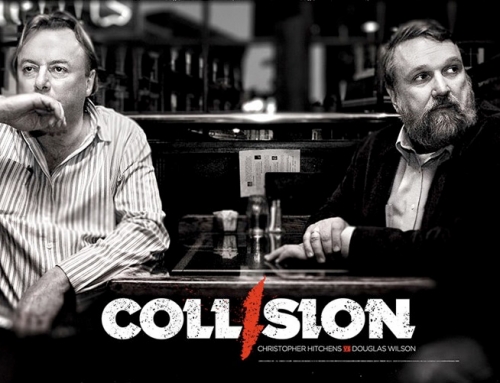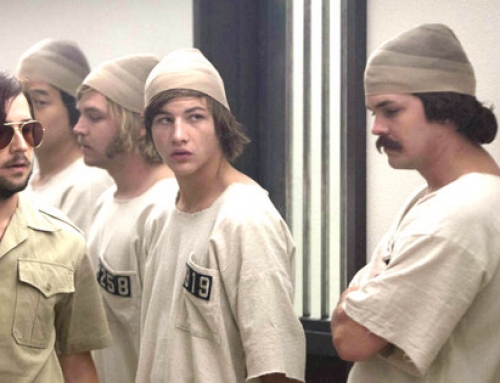The Collision Between Religious Freedom and Gay Rights
Imagine for a moment that you are a Jewish baker who owns a small bakery. One day a couple enters your establishment and orders a wedding cake to be adorned with swastikas and the likeness of Adolf Hitler. They explain that they are neo-Nazis inspired by the marriage of the Reich Minister of Propaganda Joseph Goebbels, attended by the Führer himself. You are of course offended and decline the job. Is it your legal right to refuse service to a neo-Nazi couple? If you answer in the affirmative, would you apply the same reasoning to a gay couple who requested a wedding cake adorned with two men or two women? Are these not the same moral and legal issues?
I think not. Discrimination on the basis of what you believe versus who you are constitutes different moral categories. For example, I am the publisher of a science magazine called Skeptic, which analyzes controversial claims of various kinds, from creationism and climate change to vaccinations and diets. In the mid 1990s we published an issue of Skeptic that analyzed the claims of self-professed Holocaust “revisionists”—those who believe that six million Jews were not gassed or shot in concentration camps and that the Nazis never intended to exterminate European Jewry. Despite our thorough debunking of their claims, one of the organizations contacted our offices to place an advertisement in the magazine promoting their cause. We declined to accept their business. By contrast, I would not refuse the advertising business of a black or gay organization simply because of the nature of the people running it. The difference is between what someone believes and who someone is.
Historically, the arc of the moral universe has been bending toward justice because we have stopped treating people based on who they are by nature, such as gender, race, and most recently by sexual preference. The recent legal imbroglio over the right of businesses in Indiana and other states to refuse service to people based on their sexual preference (gay versus straight) illuminates how quickly this rights revolution is unfolding. Compared to the abolition of slavery and torture, the granting of the franchise to blacks and women, and the civil rights and women’s rights movements, the gay rights and same-sex marriage revolution is arguably the fastest in history. How did this come about, who supported it and who resisted it, and what more needs to be done to complete it?
As recently as 1960 all homosexual acts in the U.S. were illegal, except in Illinois where the first gay rights organization was founded and where sodomy was decriminalized in 1961. At that time homosexuality was considered to be a mental illness and gay people were subjected to various forms of aversive therapy. If police caught a man engaged in “lewd” behavior, his name, age, and even home address could be published in the newspaper. Bars and clubs where gays and lesbians were known to hang out were frequently raided; the police would barge in, the music would stop, the lights would go up, IDs would be checked, and men who were suspected of masquerading as women could be taken into the washrooms by female officers and checked. New York’s penal code stated that people had to wear at least three pieces of clothing befitting their gender, or face arrest.
Then came the Stonewall riots, the legendary flashpoint that for many marks the true beginning of the gay rights movement. The Stonewall Inn was a grotty, mafia-owned gay bar on Christopher Street in Greenwich Village in New York City. On the night of June 28, 1969, several police officers descended on the inn to conduct a raid in the customary manner but, this time, the patrons fought back. They stood their ground and refused to cooperate, becoming increasingly rowdy and taunting the officers with openly affectionate behavior and a chorus line of drag queens. It wasn’t long before a sympathetic crowd joined Stonewall patrons and, as the story goes, after one woman was dragged out in handcuffs and struck over the head with a billy club, the gathering erupted in anger.
The Stonewall riots have come to be understood as the high noon of the gay civil rights movement, not only in the United States, but around the world. A year after the uprising, on June 28, 1970, participants marched in the first gay pride parade on a route that went from the Stonewall Inn to Central Park; they were joined by supporters marching in Chicago, San Francisco, and Los Angeles. Now every year, pride marches commemorating Stonewall are held in cities all over the world, in countries as unlikely as Uganda, Turkey, and Israel.
What’s become known simply as Stonewall happened almost 50 years ago—so what progress has been made since then? First, the good news: in 1973, the American Psychiatric Association declassified homosexuality as a mental illness. Officially acknowledging that gays and lesbians aren’t actually insane was a necessary first step in changing attitudes toward them, and attitudes most certainly have changed. In many parts of the world, homophobia is coming to be regarded as offensive as racism.
Other arenas have also seen positive changes for LGBT citizens—including for personnel in the U.S. military. Don’t ask, don’t tell (DADT) was the official policy of the U.S. government from 1994 until 2011 that allowed closeted gay, lesbian, and bisexual personnel to serve, but only under the constant threat of immediate expulsion if they accidentally slipped up and revealed their true identities. President Obama signed legislation that repealed the policy on December 22, 2010. Professional gay athletes have been coming out of the closet, as have politicians, and in at least a handful of countries gay, lesbian, and bisexual people are allowed to marry, form families, and have children. There are now at least 15 countries that have legalized same-sex marriage, including Uruguay, Denmark, South Africa, Canada, and New Zealand, and in the U.S. a majority of states and citizens agree that it is acceptable and legal for gays to marry.
According to a 2013 survey conducted by the Pew Research Center’s Forum on Religion and Public Life the percentage of those who favor same-sex marriage is highest among the youth (Millennials) and religiously unaffiliated and lowest among older Americans and white evangelical Protestants. As the “religious freedom” laws indicate in their name, it is religion more than anything else that drives people to harden their hearts. Forty years after it was determined that homosexuality is not a mental illness, many Christian preachers, writers, and theologians still think nothing of tormenting the LGBT community by telling them that their desire to love another person of the same sex is an abomination and a disease that can be “cured” through “treatment” known as reparative therapy. The religious extremists who continue to press for such therapies fail to understand that being gay is like being left-handed—it’s not something that requires an intervention. Many Christians actually believe they are being charitable by proclaiming that they “hate the sin, not the sinner,” which is not dissimilar to what Christians declared just before torching women as witches in order to save their souls, or when Christians called for pogroms against Jews for being Christ-killers.
Mark my words: I predict that within a few years, a decade at most, Christians will come around to treating gay men and lesbians no differently from how they now treat other groups whom they previously persecuted—women, Jews, blacks. This change will not occur because of some new interpretation of a biblical passage or because of a new revelation from God. These changes will come about the same way that they always do: by the oppressed minority fighting for the right to be treated equally, and by enlightened members of the oppressing majority supporting their cause. Then Christian churches will take credit for the civil liberation of the gay community, rummage through the historical record and find those preachers who had the courage and the character to stand up for gay rights when their fellow Christians would not, and then cite those as evidence that, were it not for Christianity, gay people would still be in the closet.
Whoever gets the credit, however, the gay rights revolution is nearing completion. When the U.S. Supreme Court takes up the case in a few months they could establish precedence for all states to follow with the recognition of full rights for the LGBT citizens of this nation. The time has come.




“what you believe versus who you are” makes the difference, you say. Can you grasp that what people believe makes them who they are. And people are is governed by what they believe. Your are and atheists because of what you believe about non-belief ,And what you believe to make you a non-believer makes you who you an atheist. Meaning, its time to leave your surreal world of verbal gymnastics and join the real world.
None of this moral progress would have happened without our bill of rights, court rulings, and legislation.
While I agree with the ideas in Mr. Shermer’s article, I wonder how useful the “who you are vs. what you believe” distinction really is in practice. It works in the context of African-American civil rights, because a person’s color does not determine his beliefs. But it’s harder to apply to these “religious freedom” cases. For example, the baker refusing to produce a cake for a gay wedding can argue that his reason has nothing to do with who the customers are, but is only because of their belief that gay people deserve equal marriage rights, a belief that he finds unacceptable. (Could a business use the idea to justify discriminating against Jews, on the same grounds as Shermer’s hypothetical Nazis, because Judaism is a belief system, and nobody is genetically predetermined to adopt the cultural and religious beliefs of Judaism?) Maybe the idea could be developed further in a future article.
The difference is in your mind only, I don’t see one. Why? I’d guess it’s because you want to see a difference.
California’s civil union laws grant gay and straight couples each and every right and privilege of marriage. All of the demands beyond that have to do with suffering indignities, not violations of rights. I suffer indignities every day because of who I am and because of what I believe, and because some people are just lunkheads. Somehow, I survive. A warning for those who are perpetually aggrieved…there will always be indignities.
Michael,
I have been a subscriber to eSkeptic for several years and it is becoming clear to me that you are trading your skeptical credentials for that of an advocate. Instead of raising important and thoughtful questions that make people think and examine more than one side of an issue, you are advocating for causes. It is difficult to buck the trends, I know, especially the politically correct trends of the day. But that is part of the role of the skeptic.
With regard to the current issue, you might have questioned why India, the world’s largest democracy recently re-criminalized homosexuality, why some 75 other counties have laws against homosexuality, how we are going to come to grips with the significantly higher health risks inarguably associated with homosexuality, how the clash between religious groups and the homosexual lobby will impact our culture, and many other pertinent questions that are legitimate for a skeptic to raise.
Your coverage of this issue, along with other advocacy positions you are taking, e.g., that there is a clear causal relation between CO2 and significant global warming, despite nearly two decades of a hiatus in warming while CO2 emissions have continued to rise, is making me increasingly skeptical of you as a serious, science and cultural skeptic.
To return to the current issue, there seem to be many issues driving wedges into the common identity of Americans. The issue of normalizing homosexuality is one of those and a concern for the true skeptic is what long term impact that will have. You seem to have answered that question for your readers rather than raising it for thoughtful consideration. An assertion of a different kind that relates broadly to this issue was made by a former advisor to John F. Kennedy as late as the 1990’s. It is worthy of any skeptic’s thoughtful consideration:
“History is littered with states who have tried to combine diverse ethnic or linguistic or religious groups within a single sovereignty…[E]thnic idealogues…have set themselves against the old American idea of assimilation. They call on the republic to think in terms not of individual but of group identity and to move the polity from individual rights to group rights.…They have done their best to turn a college generation against Europe and the Western tradition.…They have encouraged minorities to see themselves as victims and to live by alibis…They have filled the air with recrimination and rancor and have remarkably advanced the fragmentation of American life.”
— from Arthur Schlesinger’s “The disuniting of America.”
How does no one understand that this is a matter of property rights?
Robert, do you mean property rights as in, infringement of property rights allowed by public accommodation laws that started in 1964? And the desire to be designated a “protected class” so that one can take advantage of public accommodation laws to violate property rights. Or do you mean something else?